Report on Funding Models & Organizational Behaviour in Australia
VerifiedAdded on 2023/06/04
|7
|1459
|273
Report
AI Summary
This report provides an analysis of various funding models used in organizational behaviour, with a specific focus on Australian public hospitals. It examines normative pricing, pay-for-performance, quality structure pricing, and best practice pricing models, detailing how these incentives impact service delivery and quality of care. The report further discusses the National Efficient Price (NEP) and its role in promoting quality services, reducing costs, and improving health outcomes for indigenous Australians. The analysis highlights how incentives drive improvements in hospital services and encourage cost reduction strategies, ultimately benefiting both the healthcare system and patients. Desklib provides access to this and many other solved assignments for students.
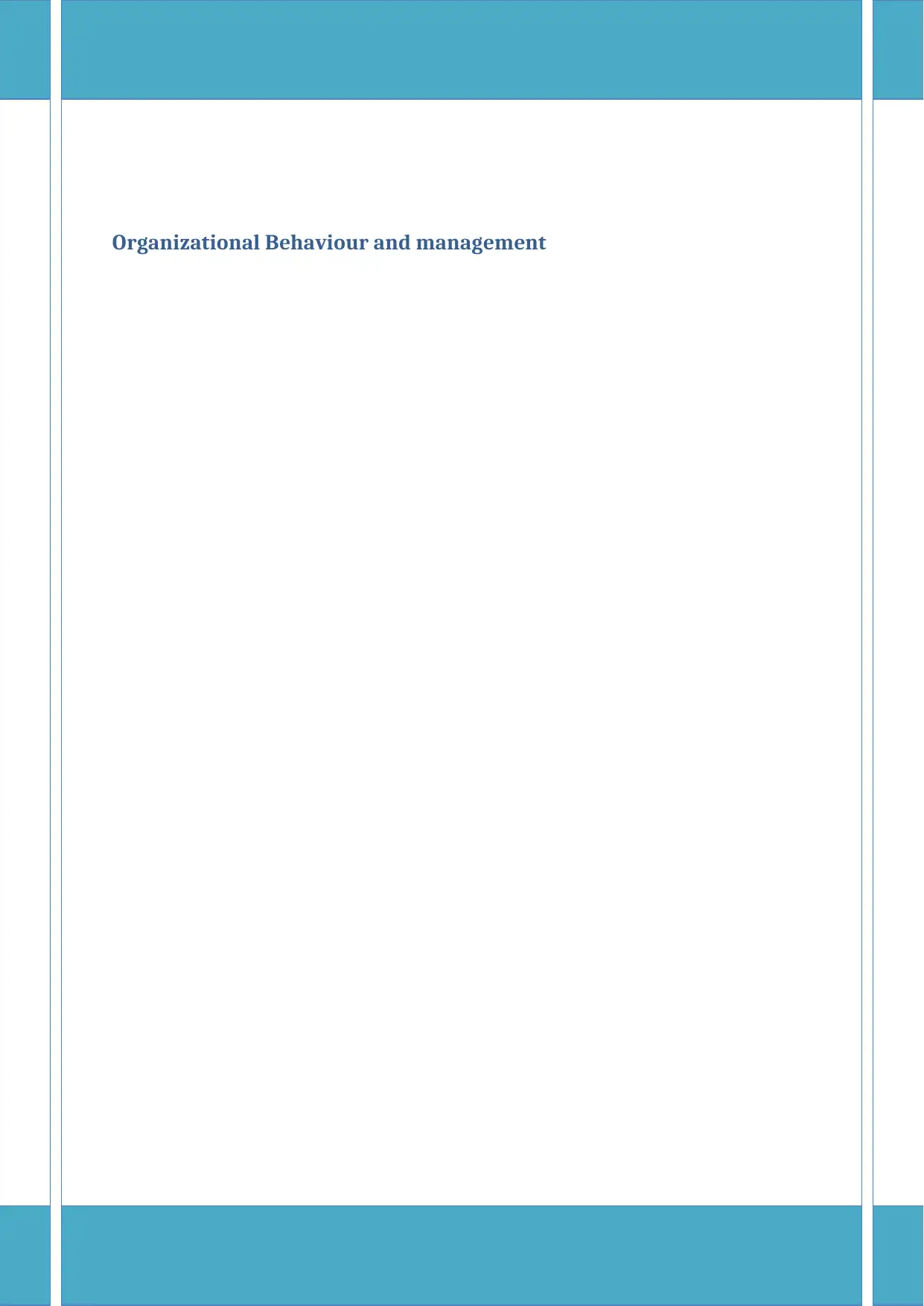
Organizational Behaviour and management
Paraphrase This Document
Need a fresh take? Get an instant paraphrase of this document with our AI Paraphraser
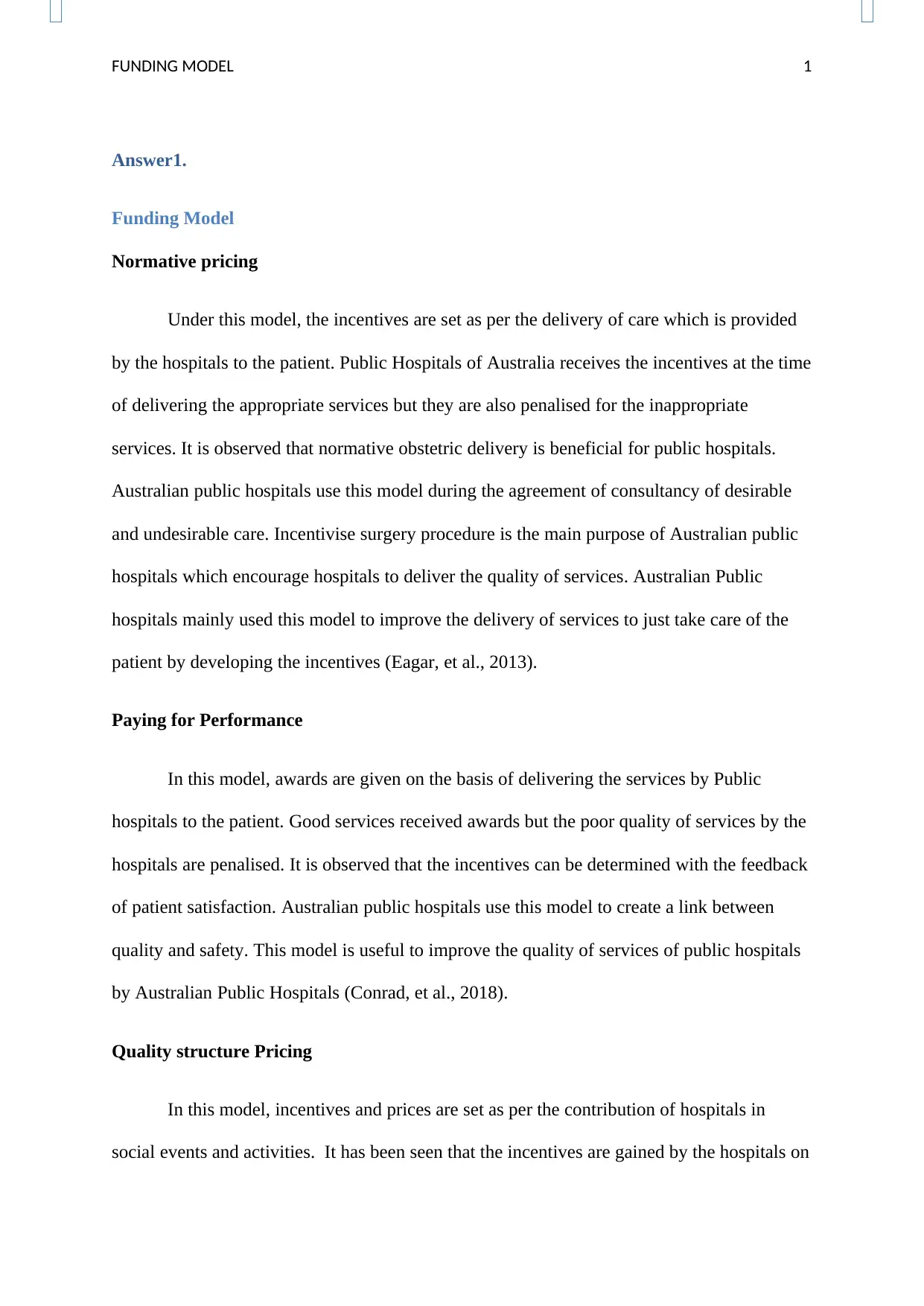
FUNDING MODEL 1
Answer1.
Funding Model
Normative pricing
Under this model, the incentives are set as per the delivery of care which is provided
by the hospitals to the patient. Public Hospitals of Australia receives the incentives at the time
of delivering the appropriate services but they are also penalised for the inappropriate
services. It is observed that normative obstetric delivery is beneficial for public hospitals.
Australian public hospitals use this model during the agreement of consultancy of desirable
and undesirable care. Incentivise surgery procedure is the main purpose of Australian public
hospitals which encourage hospitals to deliver the quality of services. Australian Public
hospitals mainly used this model to improve the delivery of services to just take care of the
patient by developing the incentives (Eagar, et al., 2013).
Paying for Performance
In this model, awards are given on the basis of delivering the services by Public
hospitals to the patient. Good services received awards but the poor quality of services by the
hospitals are penalised. It is observed that the incentives can be determined with the feedback
of patient satisfaction. Australian public hospitals use this model to create a link between
quality and safety. This model is useful to improve the quality of services of public hospitals
by Australian Public Hospitals (Conrad, et al., 2018).
Quality structure Pricing
In this model, incentives and prices are set as per the contribution of hospitals in
social events and activities. It has been seen that the incentives are gained by the hospitals on
Answer1.
Funding Model
Normative pricing
Under this model, the incentives are set as per the delivery of care which is provided
by the hospitals to the patient. Public Hospitals of Australia receives the incentives at the time
of delivering the appropriate services but they are also penalised for the inappropriate
services. It is observed that normative obstetric delivery is beneficial for public hospitals.
Australian public hospitals use this model during the agreement of consultancy of desirable
and undesirable care. Incentivise surgery procedure is the main purpose of Australian public
hospitals which encourage hospitals to deliver the quality of services. Australian Public
hospitals mainly used this model to improve the delivery of services to just take care of the
patient by developing the incentives (Eagar, et al., 2013).
Paying for Performance
In this model, awards are given on the basis of delivering the services by Public
hospitals to the patient. Good services received awards but the poor quality of services by the
hospitals are penalised. It is observed that the incentives can be determined with the feedback
of patient satisfaction. Australian public hospitals use this model to create a link between
quality and safety. This model is useful to improve the quality of services of public hospitals
by Australian Public Hospitals (Conrad, et al., 2018).
Quality structure Pricing
In this model, incentives and prices are set as per the contribution of hospitals in
social events and activities. It has been seen that the incentives are gained by the hospitals on
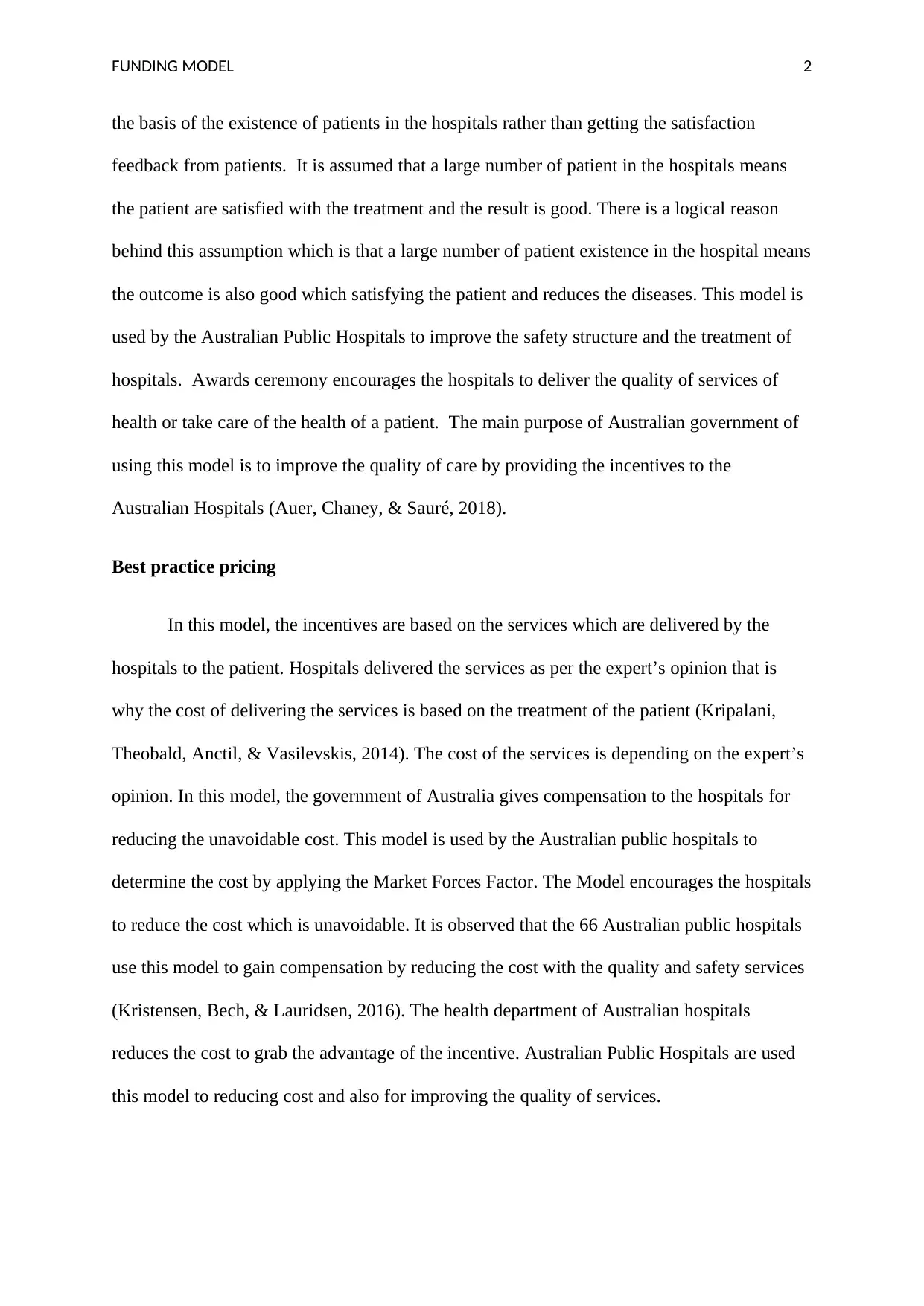
FUNDING MODEL 2
the basis of the existence of patients in the hospitals rather than getting the satisfaction
feedback from patients. It is assumed that a large number of patient in the hospitals means
the patient are satisfied with the treatment and the result is good. There is a logical reason
behind this assumption which is that a large number of patient existence in the hospital means
the outcome is also good which satisfying the patient and reduces the diseases. This model is
used by the Australian Public Hospitals to improve the safety structure and the treatment of
hospitals. Awards ceremony encourages the hospitals to deliver the quality of services of
health or take care of the health of a patient. The main purpose of Australian government of
using this model is to improve the quality of care by providing the incentives to the
Australian Hospitals (Auer, Chaney, & Sauré, 2018).
Best practice pricing
In this model, the incentives are based on the services which are delivered by the
hospitals to the patient. Hospitals delivered the services as per the expert’s opinion that is
why the cost of delivering the services is based on the treatment of the patient (Kripalani,
Theobald, Anctil, & Vasilevskis, 2014). The cost of the services is depending on the expert’s
opinion. In this model, the government of Australia gives compensation to the hospitals for
reducing the unavoidable cost. This model is used by the Australian public hospitals to
determine the cost by applying the Market Forces Factor. The Model encourages the hospitals
to reduce the cost which is unavoidable. It is observed that the 66 Australian public hospitals
use this model to gain compensation by reducing the cost with the quality and safety services
(Kristensen, Bech, & Lauridsen, 2016). The health department of Australian hospitals
reduces the cost to grab the advantage of the incentive. Australian Public Hospitals are used
this model to reducing cost and also for improving the quality of services.
the basis of the existence of patients in the hospitals rather than getting the satisfaction
feedback from patients. It is assumed that a large number of patient in the hospitals means
the patient are satisfied with the treatment and the result is good. There is a logical reason
behind this assumption which is that a large number of patient existence in the hospital means
the outcome is also good which satisfying the patient and reduces the diseases. This model is
used by the Australian Public Hospitals to improve the safety structure and the treatment of
hospitals. Awards ceremony encourages the hospitals to deliver the quality of services of
health or take care of the health of a patient. The main purpose of Australian government of
using this model is to improve the quality of care by providing the incentives to the
Australian Hospitals (Auer, Chaney, & Sauré, 2018).
Best practice pricing
In this model, the incentives are based on the services which are delivered by the
hospitals to the patient. Hospitals delivered the services as per the expert’s opinion that is
why the cost of delivering the services is based on the treatment of the patient (Kripalani,
Theobald, Anctil, & Vasilevskis, 2014). The cost of the services is depending on the expert’s
opinion. In this model, the government of Australia gives compensation to the hospitals for
reducing the unavoidable cost. This model is used by the Australian public hospitals to
determine the cost by applying the Market Forces Factor. The Model encourages the hospitals
to reduce the cost which is unavoidable. It is observed that the 66 Australian public hospitals
use this model to gain compensation by reducing the cost with the quality and safety services
(Kristensen, Bech, & Lauridsen, 2016). The health department of Australian hospitals
reduces the cost to grab the advantage of the incentive. Australian Public Hospitals are used
this model to reducing cost and also for improving the quality of services.
⊘ This is a preview!⊘
Do you want full access?
Subscribe today to unlock all pages.

Trusted by 1+ million students worldwide
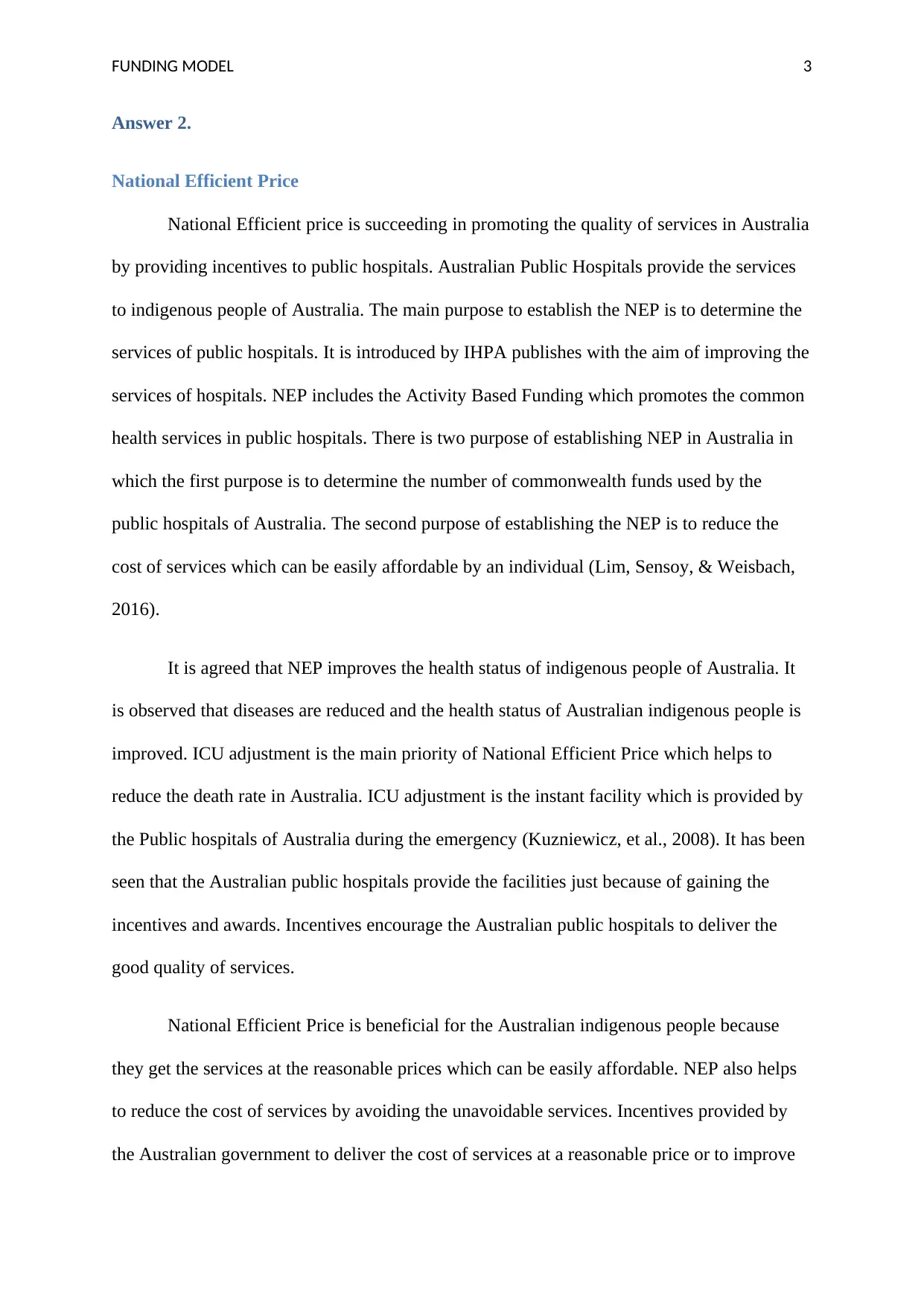
FUNDING MODEL 3
Answer 2.
National Efficient Price
National Efficient price is succeeding in promoting the quality of services in Australia
by providing incentives to public hospitals. Australian Public Hospitals provide the services
to indigenous people of Australia. The main purpose to establish the NEP is to determine the
services of public hospitals. It is introduced by IHPA publishes with the aim of improving the
services of hospitals. NEP includes the Activity Based Funding which promotes the common
health services in public hospitals. There is two purpose of establishing NEP in Australia in
which the first purpose is to determine the number of commonwealth funds used by the
public hospitals of Australia. The second purpose of establishing the NEP is to reduce the
cost of services which can be easily affordable by an individual (Lim, Sensoy, & Weisbach,
2016).
It is agreed that NEP improves the health status of indigenous people of Australia. It
is observed that diseases are reduced and the health status of Australian indigenous people is
improved. ICU adjustment is the main priority of National Efficient Price which helps to
reduce the death rate in Australia. ICU adjustment is the instant facility which is provided by
the Public hospitals of Australia during the emergency (Kuzniewicz, et al., 2008). It has been
seen that the Australian public hospitals provide the facilities just because of gaining the
incentives and awards. Incentives encourage the Australian public hospitals to deliver the
good quality of services.
National Efficient Price is beneficial for the Australian indigenous people because
they get the services at the reasonable prices which can be easily affordable. NEP also helps
to reduce the cost of services by avoiding the unavoidable services. Incentives provided by
the Australian government to deliver the cost of services at a reasonable price or to improve
Answer 2.
National Efficient Price
National Efficient price is succeeding in promoting the quality of services in Australia
by providing incentives to public hospitals. Australian Public Hospitals provide the services
to indigenous people of Australia. The main purpose to establish the NEP is to determine the
services of public hospitals. It is introduced by IHPA publishes with the aim of improving the
services of hospitals. NEP includes the Activity Based Funding which promotes the common
health services in public hospitals. There is two purpose of establishing NEP in Australia in
which the first purpose is to determine the number of commonwealth funds used by the
public hospitals of Australia. The second purpose of establishing the NEP is to reduce the
cost of services which can be easily affordable by an individual (Lim, Sensoy, & Weisbach,
2016).
It is agreed that NEP improves the health status of indigenous people of Australia. It
is observed that diseases are reduced and the health status of Australian indigenous people is
improved. ICU adjustment is the main priority of National Efficient Price which helps to
reduce the death rate in Australia. ICU adjustment is the instant facility which is provided by
the Public hospitals of Australia during the emergency (Kuzniewicz, et al., 2008). It has been
seen that the Australian public hospitals provide the facilities just because of gaining the
incentives and awards. Incentives encourage the Australian public hospitals to deliver the
good quality of services.
National Efficient Price is beneficial for the Australian indigenous people because
they get the services at the reasonable prices which can be easily affordable. NEP also helps
to reduce the cost of services by avoiding the unavoidable services. Incentives provided by
the Australian government to deliver the cost of services at a reasonable price or to improve
Paraphrase This Document
Need a fresh take? Get an instant paraphrase of this document with our AI Paraphraser
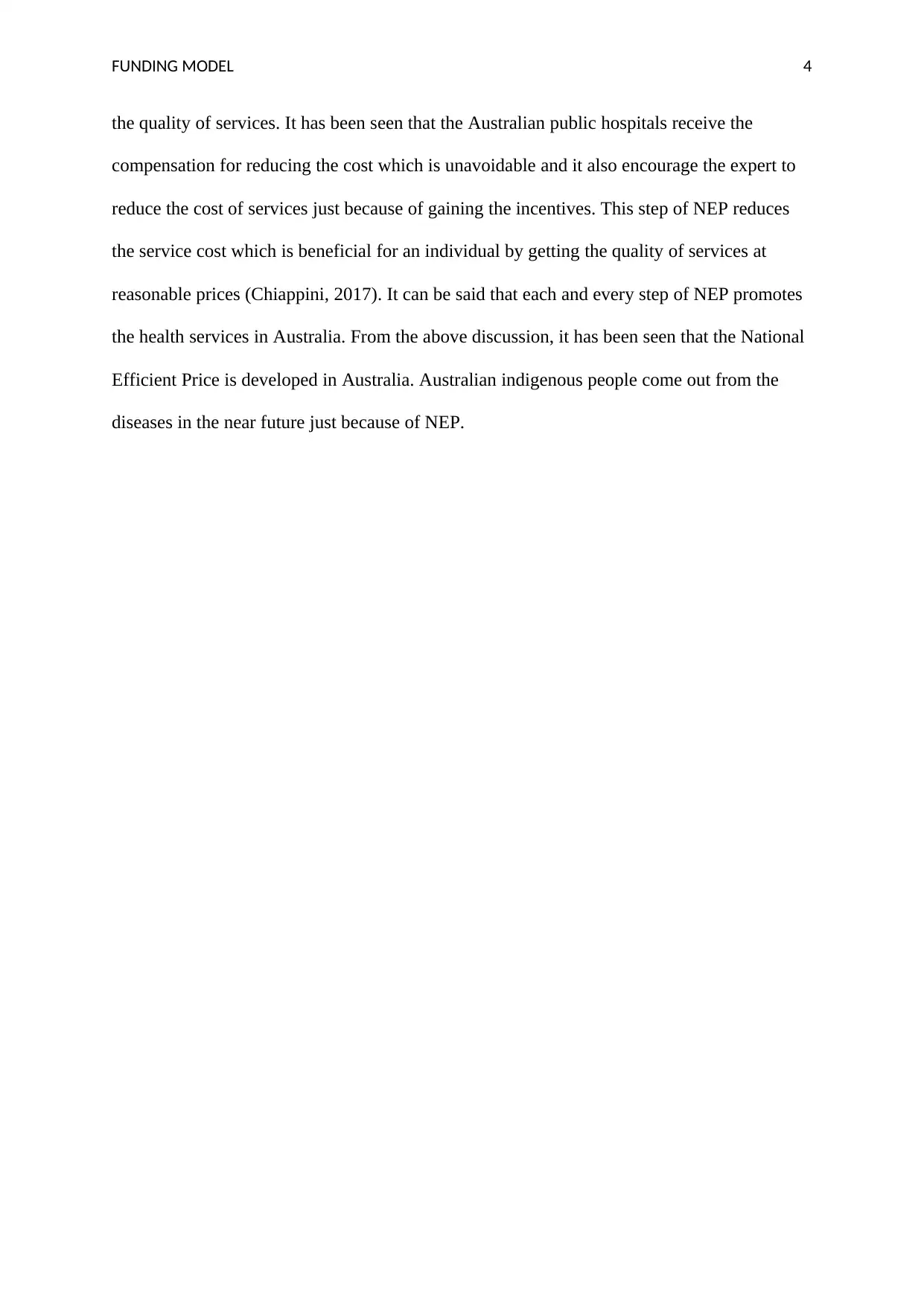
FUNDING MODEL 4
the quality of services. It has been seen that the Australian public hospitals receive the
compensation for reducing the cost which is unavoidable and it also encourage the expert to
reduce the cost of services just because of gaining the incentives. This step of NEP reduces
the service cost which is beneficial for an individual by getting the quality of services at
reasonable prices (Chiappini, 2017). It can be said that each and every step of NEP promotes
the health services in Australia. From the above discussion, it has been seen that the National
Efficient Price is developed in Australia. Australian indigenous people come out from the
diseases in the near future just because of NEP.
the quality of services. It has been seen that the Australian public hospitals receive the
compensation for reducing the cost which is unavoidable and it also encourage the expert to
reduce the cost of services just because of gaining the incentives. This step of NEP reduces
the service cost which is beneficial for an individual by getting the quality of services at
reasonable prices (Chiappini, 2017). It can be said that each and every step of NEP promotes
the health services in Australia. From the above discussion, it has been seen that the National
Efficient Price is developed in Australia. Australian indigenous people come out from the
diseases in the near future just because of NEP.
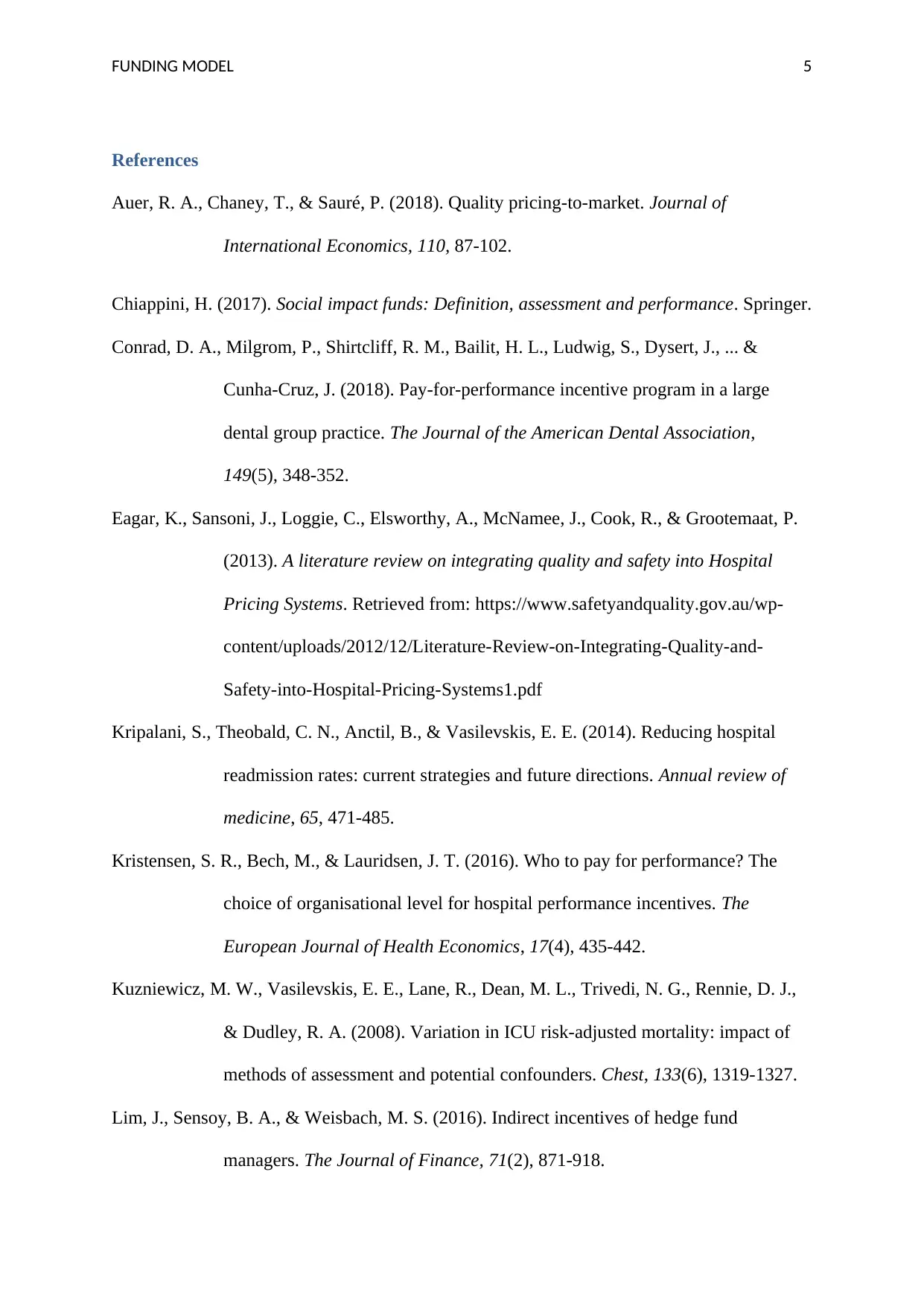
FUNDING MODEL 5
References
Auer, R. A., Chaney, T., & Sauré, P. (2018). Quality pricing-to-market. Journal of
International Economics, 110, 87-102.
Chiappini, H. (2017). Social impact funds: Definition, assessment and performance. Springer.
Conrad, D. A., Milgrom, P., Shirtcliff, R. M., Bailit, H. L., Ludwig, S., Dysert, J., ... &
Cunha-Cruz, J. (2018). Pay-for-performance incentive program in a large
dental group practice. The Journal of the American Dental Association,
149(5), 348-352.
Eagar, K., Sansoni, J., Loggie, C., Elsworthy, A., McNamee, J., Cook, R., & Grootemaat, P.
(2013). A literature review on integrating quality and safety into Hospital
Pricing Systems. Retrieved from: https://www.safetyandquality.gov.au/wp-
content/uploads/2012/12/Literature-Review-on-Integrating-Quality-and-
Safety-into-Hospital-Pricing-Systems1.pdf
Kripalani, S., Theobald, C. N., Anctil, B., & Vasilevskis, E. E. (2014). Reducing hospital
readmission rates: current strategies and future directions. Annual review of
medicine, 65, 471-485.
Kristensen, S. R., Bech, M., & Lauridsen, J. T. (2016). Who to pay for performance? The
choice of organisational level for hospital performance incentives. The
European Journal of Health Economics, 17(4), 435-442.
Kuzniewicz, M. W., Vasilevskis, E. E., Lane, R., Dean, M. L., Trivedi, N. G., Rennie, D. J.,
& Dudley, R. A. (2008). Variation in ICU risk-adjusted mortality: impact of
methods of assessment and potential confounders. Chest, 133(6), 1319-1327.
Lim, J., Sensoy, B. A., & Weisbach, M. S. (2016). Indirect incentives of hedge fund
managers. The Journal of Finance, 71(2), 871-918.
References
Auer, R. A., Chaney, T., & Sauré, P. (2018). Quality pricing-to-market. Journal of
International Economics, 110, 87-102.
Chiappini, H. (2017). Social impact funds: Definition, assessment and performance. Springer.
Conrad, D. A., Milgrom, P., Shirtcliff, R. M., Bailit, H. L., Ludwig, S., Dysert, J., ... &
Cunha-Cruz, J. (2018). Pay-for-performance incentive program in a large
dental group practice. The Journal of the American Dental Association,
149(5), 348-352.
Eagar, K., Sansoni, J., Loggie, C., Elsworthy, A., McNamee, J., Cook, R., & Grootemaat, P.
(2013). A literature review on integrating quality and safety into Hospital
Pricing Systems. Retrieved from: https://www.safetyandquality.gov.au/wp-
content/uploads/2012/12/Literature-Review-on-Integrating-Quality-and-
Safety-into-Hospital-Pricing-Systems1.pdf
Kripalani, S., Theobald, C. N., Anctil, B., & Vasilevskis, E. E. (2014). Reducing hospital
readmission rates: current strategies and future directions. Annual review of
medicine, 65, 471-485.
Kristensen, S. R., Bech, M., & Lauridsen, J. T. (2016). Who to pay for performance? The
choice of organisational level for hospital performance incentives. The
European Journal of Health Economics, 17(4), 435-442.
Kuzniewicz, M. W., Vasilevskis, E. E., Lane, R., Dean, M. L., Trivedi, N. G., Rennie, D. J.,
& Dudley, R. A. (2008). Variation in ICU risk-adjusted mortality: impact of
methods of assessment and potential confounders. Chest, 133(6), 1319-1327.
Lim, J., Sensoy, B. A., & Weisbach, M. S. (2016). Indirect incentives of hedge fund
managers. The Journal of Finance, 71(2), 871-918.
⊘ This is a preview!⊘
Do you want full access?
Subscribe today to unlock all pages.

Trusted by 1+ million students worldwide

FUNDING MODEL 6
1 out of 7
Related Documents
Your All-in-One AI-Powered Toolkit for Academic Success.
+13062052269
info@desklib.com
Available 24*7 on WhatsApp / Email
![[object Object]](/_next/static/media/star-bottom.7253800d.svg)
Unlock your academic potential
Copyright © 2020–2025 A2Z Services. All Rights Reserved. Developed and managed by ZUCOL.





